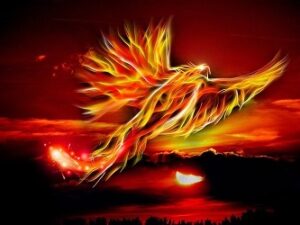
The lyrics to this piece come from the contemporary poet Charles A. Silvestri, who “specializes in providing bespoke poetry for choral composers.” Rather like a custom tailor, I guess. He has written the lyrics for a number of pieces by the Norwegian choral composer Ola Gjeilo and says of this one that “The fiery sky at sunset was an inspiration for this poem about a phoenix preparing for rebirth.. . . Ola had asked me for several poems relating to the theme of rebirth, and I gave him this twist on the usual theme.”
So what’s the twist? Actually I think there are two, with the secondary one’s being that Silvestri has the bird itself speaking. I think we’re all vaguely aware that a phoenix is a creature who dies, usually in flames, and then rises anew from its own ashes. There’s quite a variation in the stories of this ever-renewing bird, with the word “phoenix” itself being found in ancient Greek. Many other cultures have had similar tales of the reborn bird; the “firebird” appears in the Russian version of the story, for instance.
Enough historical background. Let’s take a look at the actual lyrics of the piece. The phoenix’s feathers are now gray where once they were red and gold (the most common colors used in descriptions), and it knows that soon it will be “born again in flame.” But—and here’s the major twist—it is not going to die on some sort of funeral pyre and then physically rise again, as is usually the case. Instead, it is going to plunge into the sun itself. This meaning is borne out by the first verses of the original poem, words that Gjeilo did not include in his composition:
Weary, I fly,
Across the vast eternal sky,
High in the heavens,
Where awaits my destiny.
Grey skies are thickening;
Soon now my time will come,
Time to return home
‘Cross the vast eternal sky.
So how is the phoenix going to be reborn if he has disappeared into the sun? The ending lines, both of the poem and of the song, have the bird say this:
Do not despair that I am gone away;
I will appear again
When the sunset paints
Flames across the vast eternal sky!
I don’t want to make the mistake of trying to pin down the meaning too strictly here; otherwise I may end up sounding like something from a Hallmark card. I’ll just say that in Silvestri’s hands the myth has become something less literal and more universal. Upon his death the phoenix will be translated, as it were, into another, much larger medium.
You get two performance videos below. The first one uses the string quartet that the composer called for, and, as an added bonus, Gjeilo is also the pianist. Many performances now use an accordion along with the quartet, a choice I found inexplicable–until my own choir, the Cherry Creek Chorale, used that instrument in a performance. I liked it! So you can listen to that one, too. (There’s some backstory about how one early performance used an accordion and the idea just took off.)
Sunlight shines on my face;
This is my grace, to be
Restored, born again,
In flame.
When I was young I flew in the velvet night;
Shining by day, a firebird bathed in light!
Grey now my feathers, which once were red and gold;
My destiny to soar up to the sun
Sunlight shines on my face;
This is my grace, to be
Restored, born again,
In flame.
Do not despair that I am gone away;
I will appear again
When the sunset paints
Flames across the vast, eternal sky.
All lines from the poem are © Charles Anthony Silvestri, included in this post with my understanding of fair use for educational not-for-profit materials.
© Debi Simons

